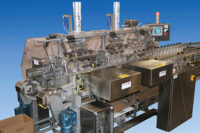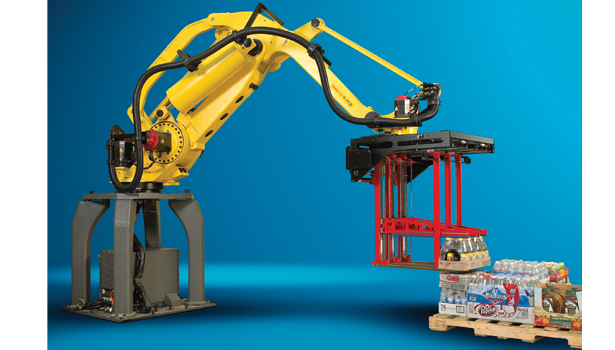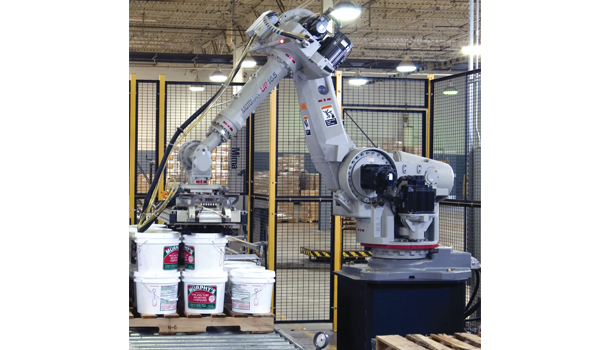Robotic equipment forges a new future
Automation provides reliable, flexible machinery






The concept of robotic aids have gone beyond Rosie the maid in the cartoon series “The Jetsons” and been embraced by modern households in everyday solutions, such as the Roomba brand of automated vacuums. For beverage-makers and distributors, robotic solutions have come to embody reliable, flexible and safer options for their operations. Within the industry, installation of robotic equipment continues to grow with new applications for manufacturing and distribution, experts say.
“If you rewind seven, eight or 10 years, robotics were probably considered pretty novel, and there was a lot of uncertainty,” says Dick Motley, account manager for North American Distribution for Fanuc Robotics, Rochester Hills, Mich. “I think at this point there’s a real proven track record, and there’s a recognition of the reliability and the flexibility that they deliver.”
Flexibility also compounds with additional advantages, explains Earl Wohlrab, manager of robot integrations for Intelligrated, Cincinnati.
“The official answer is probably flexibility and minimal changeover time,” Wohlrab says. “The unofficial answer is probably sex appeal. Everybody wants a robot in their factory now.”
Cause and effect
The overall industry movement toward lightweighted packaging has increased the need for robotic solutions that are able to gently handle products. The decrease in primary packaging weight as well as the move to lessen secondary packaging has spurred an increase in demand for robotics as traditional machinery often included maneuvers, such as bump-turns, which could potentially damage lightweighted products, says James Cooper, vice president of sales and marketing for Kuka Robotics Corp., Clinton Township, Mich.
Fanuc Robotics’ Motley relates an example encountered by its integration partner Hartness International Inc., Greenville, S.C., in which a manufacturer had lightweighted its bottled water packaging to thinner-walled PET bottles in cases with only shrink wrap and no corrugated cardboard.
“The bottled water products were like a big bag of water balloons, basically, because they did such a good job of reducing the packaging,” Motley explains. “The problem was when they went to run those products on their conventional bump-turn style palletizing equipment, it was destroying the product. So they made a huge investment at this point to bring this product to market and now they couldn’t ship it.”
Hartness developed a Fanuc-based robotic solution that combined a robot that gently aligns the product into a palletizing pattern, then a larger robot takes a full layer of product supported on large grippers to gently deposit it on the load, Motley says.
Fanuc robots have shown mean-time between failure rates as high as 100,000 hours, he says. However, when maintenance is required, the machinery offers an advantage compared to traditional equipment, Motley notes.
“For serviceability and maintenance on traditional machinery, you have to climb ladders and go to elevated platforms and things like that, where robot systems are right there at ground level,” he says. “If there is a jam-up, it’s easy to see, it’s not hidden at an elevated level. It’s easy to correct and it’s safe to correct because you’re just standing on the ground. That typically translates to higher up-time.”
In addition to lightweighted packaging, Kuka’s Cooper notes the proliferation of package configurations, explaining that plants need to have the flexibility to run 12-, 18- and 24-packs.
SKU proliferation also is cited by Grimsby, Ontario-based RMT Robotics, which designs custom robotic solutions for distributors.
“We are going into applications that maybe today are running 150 to 200 SKUs, but when they are looking at designing a system with us, they are looking at 340 to 400 SKUs,” says Derek Rickard, distribution systems manager for RMT Robotics. “They can see that it’s growing and they need to do something about it. If they don’t do something about it, the footprint of their facility just grows and grows and grows for the picking area and then they need to expand the building.”
RMT Robotics often is able to offer an automated picking system in less space than a manual system, Rickard says. The company recently installed a large-scale robotic case picking solution for Canadian company Brewers Distributor Ltd. The system has a footprint of less than 40,000 square feet and is designed to pick 300 SKUs at a rate of more than 250,000 cases a day, the company says. It includes several robotic gantries that pick a mixture of loose cases and full layers, RMT Robotics notes.
Footprint also is a concern that inspired Intelligrated to offer its Alvey 950 palletizing solution, Wohlrab says.
“A lot of these high-speed beverage manufacturers already have big in-line machines out in their warehouses that do high-speed palletizing, so [the Alvey 950] mimics that machine in that footprint, so they are easier to plug in,” he says.
Flexibility often is a demand from customers of Brewerton, N.Y.-based Schneider Packaging Equipment Corp. The company offers the Robotic Top-Load Case Packer to handle a variety of product and case types, says Terry Zarnowski, sales and marketing director for Schneider Packaging. The model is designed to load 12-count cases of liquor and wine in applications that need to be able to handle a wide variety of bottle types and shapes, Zarnowski says. By changing the end-of-arm tooling, the machine can switch between an array of product shapes and container materials, he says.
Schneider Packaging also offers the Add-Pal solution that connects a case packer and a single-line palletizer to create display-ready pallets at high speeds, Zarnowski says. The machine is designed to handle cases, trays, carton-packaged products and bundled options, he says. For off-set bundle packages, the company uses a mechanical clamping-style gripper designed for that application, he notes.
In some applications, robotic palletizing also can increase efficiency, he notes.
“In palletizing applications, one robot can handle multiple SKUs simultaneously, enabling the output of two to four lines to be palletized simultaneously, reducing the number of palletizers required,” Zarnowski says.
Layering the benefits
The proliferation of packages has led to an increased demand for robotic layer forming machinery, Kuka’s Cooper says. For high-volume applications in distribution warehouses, RMT Robotics offers a standalone layer picker or can create a solution that combines a case picker and layer picker, Rickard says.
Kuka’s Cooper says the company’s machinery partners are developing automated options to feed a traditional palletizer or fully robotic palletizers. The robotic layer-forming solutions offer flexibility and reliability with current solutions offering 70,000 hours of mean-time between failure rates, he notes.
Kuka Systems recently installed a layer palletizing and case picking line for one of North America’s leading beverage companies. The system can process 5,000 cases an hour and features fully automated processing of the regional center’s highest demand products, which make up approximately 65 percent of the customer’s order volume, the company says.
The project marked the first time that Kuka Systems served as general contractor using previously utilized technologies such as Kuka Systems’ automated high-speed layer-picking system, layer-forming and mixed-palletizing cell. It also includes a state-of-the-art layer-picking head that lifts cases from underneath to help reduce the risk of product damage associated with traditional clamp or vacuum grip-based technologies, the company says.
Layer-forming machines also offer distributors an option to create graphic displays through package placement. The robotic equipment can be programmed to arrange cases of a product or a variety of products in a manner that would create an image or effect for display at retail, he says.
In addition, the layer-picking machines offer flexibility to adapt to new trends, Kuka’s Cooper says.
“Many beverage producers are looking to their future needs and really not knowing what the package configuration will be a couple years down the road,” he says. “[Customers] are wanting to have that flexibility to be able to respond to the market demands with different sized package configurations and different pallet patterns.”
Advanced options
Lightweighted packaging is not the only trend affecting robotic development. Kuka’s Cooper notes one of its partners, Barry-Wehmiller division Fleetwood Goldco Wyard, developed a robot that cuts and removes the shrink wrap from a load at the beginning of the line. This solution offers labor cost savings as the machine can replace human intervention at that stage in the line.
Schneider Packaging also offers options to create a fully integrated, complete line that can handle product from the filler to the truck, Zarnowski says. These integrated systems can combine additional options for product, case and pallet labeling as well as tray-shrink wrap, pallet stretch wrap and banding options. The company also can integrate conveyors and automated guided vehicles into the solution, he says.
Inspired by its customers, Fanuc Robotics welcomes innovative ideas from its equipment partners, Motley says.
“They also send feedback and say, ‘You know what? It would be great if this product would only do…’ and we love for them to finish that sentence and tell us what the next product development is that we should be doing to serve their needs and the needs of the end-user,” he says.
Fanuc Robotics also continues to innovate. “On our side, we keep pushing the envelope in terms of performance,” Motley says. “Our robots are going faster. They’re able to do higher throughput rates. We’re doing more in the way of software functionality for ease of use and higher performance.”
Fanuc Robotics also is working with sensory capabilities, vision systems and sensing accessories that would enable a robot to see and recognize products, and possibly in the future, screen defects and verify product weights, Motley says.
At Pack Expo, Intelligrated featured two robotic arms unpacking and packing bottles that operated on a single programmable logic controller (PLC)-based control system. The benefits of the PLC-controlled warehouse systems could help robotic solutions expand in the future, Intelligrated’s Wohlrab says.
“As we move down the PLC road, that common control will allow us to control greater portions of the line,” he says. “I think robots will start permeating further into more traditional market spaces. If we can get the speed up a little bit for robots and it’s PLC controlled, you could have little end-of-line systems where one PLC might be controlling the packer, sealer and palletizer, and then the robot can be incorporated into the case packer and maybe some dynamic labeling or some other solution coupled with vision.” BI
Looking for a reprint of this article?
From high-res PDFs to custom plaques, order your copy today!









